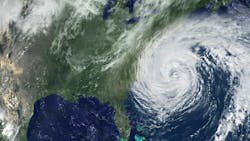NOAA research predicts an increase in active Atlantic hurricane seasons
In a new study published in Science Advances, NOAA and partner researchers project an increase in the variability of Atlantic tropical cyclone activity, leading to more active and inactive hurricane seasons and less near-normal seasons.
The study investigated how the frequency and accumulated cyclone energy (ACE in the North Atlantic could change the future.
According to a NOAA news article, ACE is the measure of total seasonal activity used by NOAA scientists to investigate past and future changes in tropical cyclone activity, focusing on changes that occur between or over two or more years and the impact of climate change.
The researchers examined why there have been so many active seasons in recent years.
The results show both unusually active and inactive hurricane seasons have become more frequent. According to NOAA, computer models predict that by the middle of this century, the variability could increase by an additional 36%, with the biggest increase expected to occur in the central tropical North Atlantic, which refers to the mid-section of the ocean where storms frequently form.
The changes are attributed to shifts in wind patterns and ocean temperatures.
The study indicated that changes in wind shear can have an impact on a tropical cyclone’s development. Low vertical windshear is a contributing condition to the formation of storms, as well as existing weather disturbances, warm ocean water and thunderstorm activity.
According to NOAA, changes in vertical wind shear and atmospheric stability, driven by ocean temperature differences between the Pacific and Atlantic Oceans, are responsible for the shift in variability. These changes are expected to become more evident in the future, further intensifying the variability in Atlantic hurricane seasons.
The study also found that the total number of storms, when average out over many years, shouldn’t change much. However, the likelihood of extremely active seasons will increase due to a projected increase in the year-to-year variations, according to NOAA.
This variability between busy and quiet hurricane seasons can pose challenges for communities and scientists.
NOAA states that variability can make it difficult for scientists to predict the severity of any given hurricane season. It also creates challenges for disaster preparedness. This means that communities in hurricane-prone areas will need to prepare for seasons that have the potential to be extremely active.


